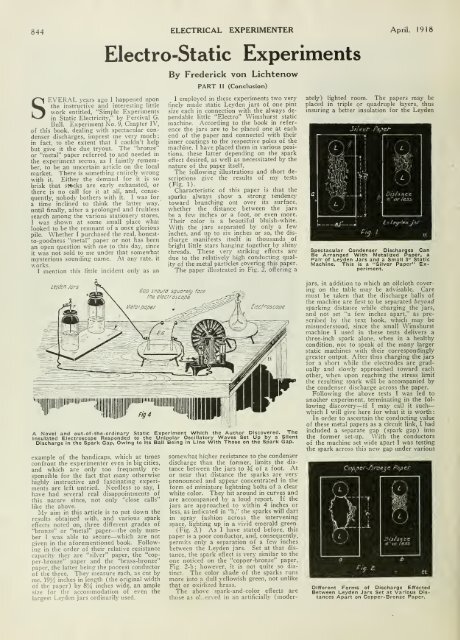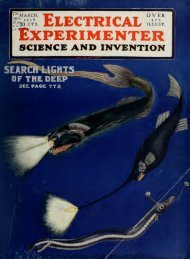The Electrical experimenter
The Electrical experimenter
The Electrical experimenter
You also want an ePaper? Increase the reach of your titles
YUMPU automatically turns print PDFs into web optimized ePapers that Google loves.
844 ELECTRICAL EXPERIMENTER April, 1918<br />
SEVERAL<br />
years ago I happened upon<br />
the instructive and interesting little<br />
work entitled, "Simple Experiments<br />
in Static Electricity," by Percival G.<br />
Bull. Experiment No. 9, Chapter IV,<br />
of this book, dealing with spectacular con-<br />
denser discharges, imprest me very much<br />
in fact, to the extent that I couldn't help<br />
but give it the due tryout. <strong>The</strong> "bronze"<br />
or "metal" paper referred to and needed in<br />
the experiment seems, as I faintly remember,<br />
to be an uncertain article on the local<br />
market. <strong>The</strong>re is something entirely wrong<br />
with it. Either the demand for it is so<br />
brisk that stecks are early exhausted, or<br />
there is no call for it at all, and, consequently,<br />
nobody bothers with it. I was for<br />
a time inclined to think the latter way,'<br />
until finally, after a prolonged and fruitless<br />
search among the various stationery stores,<br />
I was shown at some small place what<br />
looked to be the remnant of a once glorious<br />
pile. Whether I purchased the real, honestto-goodness<br />
"metal" paper or not has been<br />
an open question with me to this day, since<br />
it was not sold to me under that somewhat<br />
mysterious sounding name. At any rate, it<br />
works.<br />
I mention this little incident only as an<br />
Lei/den Jors<br />
;<br />
Electro-Static Experiments<br />
By Frederick von Lichtenow<br />
PART II (Conclusion)<br />
I employed in these experiments two very<br />
finely made static Leyden jars of one pint<br />
size each in connection with the always dependable<br />
little "Electro" Wimshurst static<br />
machine. According to the book in reference<br />
the jars are to be placed one at each<br />
end of the paper and connected with their<br />
inner coatings to the respective poles of the<br />
machine. I have placed them in various positions,<br />
these latter depending on the spark<br />
effect desired, as well as necessitated by the<br />
nature of the paper itself.<br />
<strong>The</strong> following illustrations<br />
scriptions give the results<br />
and short de-<br />
of my tests<br />
< Fig -<br />
J) '<br />
Characteristic<br />
c<br />
of this paper is<br />
^<br />
that<br />
,<br />
the<br />
sparks always show a strong tendency<br />
toward branching out over its surface,<br />
whether the distance between the jars<br />
be a few inches or a foot, or even more.<br />
<strong>The</strong>ir<br />
With<br />
color is<br />
the jars<br />
a beautiful<br />
separated by<br />
bluish-white.<br />
only a few<br />
inches, and up to six inches or so, the discharge<br />
manifests itself in thousands of<br />
bright little stars hanging together by shiny<br />
threads. <strong>The</strong>se very striking effects are<br />
due to the relatively high conducting quality<br />
of the metal particles covering this paper.<br />
<strong>The</strong> paper illustrated in Fig. 2, offering a<br />
Sap snou/a squore/y face<br />
ff)e electroscope<br />
Electroscope<br />
A Novel and out-of-the-ordinary Static Experiment Which the Author Discovered. <strong>The</strong><br />
Insulated Electroscope Responded to the Unipolar Oscillatory Waves Set Up by a Silent<br />
Discharge in the Spark Gap, Owing to Its Ball Being In Line With Those on the Spark Gap.<br />
example of the handicaps, which at times<br />
confront the <strong>experimenter</strong> even in big cities,<br />
and which are<br />
sponsible for the<br />
only too frequently re-<br />
fact that many otherwise<br />
highly instructive and fascinating experiments<br />
are left untried. Needless to say, I<br />
have had several real disappointments of<br />
this nature since, not only "close calls"<br />
like the above.<br />
My aim in this article is to put down the<br />
results obtained with, and various spark<br />
effects noted on, three different grades of<br />
"bronze" or "metal" paper—the only number<br />
I was able to secure—which are not<br />
given in the aforementioned book. Following<br />
in the order of their relative resistance<br />
capacity they are "silver" paper, the "copper-bronze"<br />
paper and the "brass-bronze"<br />
paper, the latter being the poorest conductor<br />
of the three. <strong>The</strong>y measure each, as cut by<br />
me, 19^ inches in length (the original width<br />
of the paper) by &A inches wide, an ample<br />
size for the accommodation of even the<br />
largest Leyden jars ordinarily used.<br />
somewhat higher resistance to the condenser<br />
discharge than the former, limits the distance<br />
between the jars to Yi, of a foot. At<br />
or near that distance the sparks are very<br />
pronounced and appear concentrated in the<br />
form of miniature lightning bolts of a clear<br />
white color. <strong>The</strong>y hit around in curves and<br />
are accompanied by a loud report. If the<br />
jars are approached to within 4 inches or<br />
less, as indicated in "b," the sparks will dart<br />
in spray fashion across the intervening<br />
space, lighting up in a vivid emerald green.<br />
(Fig. 3.) As I have stated before, this<br />
paper is a poor conductor, and, consequently,<br />
permits only a separation of a few inches<br />
between the Leyden jars. Set at that distance,<br />
the spark effect is very similar to the<br />
one noticed on the "copper-bronze" paper,<br />
Fig. 2-b ; however, it is not quite so distinct.<br />
<strong>The</strong> color shade of the sparks runs<br />
more into a dull yellowish green, not unlike<br />
that or oxidized brass.<br />
<strong>The</strong> above spark-and-color effects are<br />
those as observed in an artificially (moder-<br />
ately) lighted room. <strong>The</strong> papers may be<br />
placed in triple or quadruple layers, thus<br />
insuring a better insulation for the Leyden<br />
Spectacular Condenser Discharges Can<br />
Be Arranged With Metalized Paper, a<br />
Pair of Leyden Jars and a Small 3" Static<br />
Machine. This is a "Silver Paper" Experiment.<br />
jars, in addition to which an oilcloth covering<br />
on the table may be advisable. Care<br />
must be taken that the discharge balls of<br />
the machine are first to be separated beyond<br />
sparking distance while charging the jars,<br />
and not set "a few inches apart," as prescribed<br />
by the text book, which may be<br />
misunderstood, since the small Wimshurst<br />
machine I used<br />
three-inch spark<br />
condition, not to<br />
in these tests delivers a<br />
alone, when in a healthy<br />
speak of the many larger<br />
static machines with their correspondingly<br />
greater output. After thus charging the jars<br />
for a short while the electrodes are gradually<br />
and slowly approached toward<br />
other, when upon reaching the stress<br />
each<br />
limit'<br />
the resulting spark will be accompanied by<br />
the condenser discharge across the paper.<br />
Following the above tests I was led to<br />
another experiment, terminating in the following<br />
discovery—if I may call it such—<br />
which I will give here for what it is worth<br />
In order to ascertain the conducting value<br />
of these metal papers as a circuit link, I had<br />
included a separate<br />
the former set-up.<br />
gap (spark gap) into<br />
With the conductors<br />
of the machine set wide apart I was testing<br />
the spark across this new gap under various<br />
Different Forms of Discharge Effected<br />
Between Leyden Jars Set at Various Distances<br />
Apart on Copper-Bronze Paper.<br />
:




